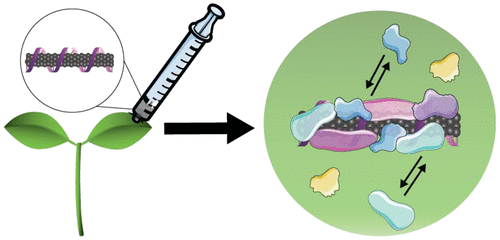Our official English website, www.x-mol.net, welcomes your
feedback! (Note: you will need to create a separate account there.)
In Planta Nanosensors: Understanding Biocorona Formation for Functional Design
ACS Sensors ( IF 8.2 ) Pub Date : 2021-07-19 , DOI: 10.1021/acssensors.1c01159 Elizabeth Voke 1 , Rebecca L Pinals 1 , Natalie S Goh 1 , Markita P Landry 1, 2, 3, 4
ACS Sensors ( IF 8.2 ) Pub Date : 2021-07-19 , DOI: 10.1021/acssensors.1c01159 Elizabeth Voke 1 , Rebecca L Pinals 1 , Natalie S Goh 1 , Markita P Landry 1, 2, 3, 4
Affiliation

|
Climate change and population growth are straining agricultural output. To counter these changes and meet the growing demand for food and energy, the monitoring and engineering of crops are becoming increasingly necessary. Nanoparticle-based sensors have emerged in recent years as new tools to advance agricultural practices. As these nanoparticle-based sensors enter and travel through the complex biofluids within plants, biomolecules including proteins, metabolites, lipids, and carbohydrates adsorb onto the nanoparticle surfaces, forming a coating known as the “bio-corona”. Understanding these nanoparticle–biomolecule interactions that govern nanosensor function in plants will be essential to successfully develop and translate nanoparticle-based sensors into broader agricultural practice.
中文翻译:

在 Planta 纳米传感器中:了解生物冠的形成以进行功能设计
气候变化和人口增长给农业产出带来压力。为了应对这些变化并满足对粮食和能源不断增长的需求,农作物的监测和工程变得越来越必要。近年来,基于纳米颗粒的传感器已成为推进农业实践的新工具。当这些基于纳米颗粒的传感器进入并穿过植物内复杂的生物流体时,包括蛋白质、代谢物、脂质和碳水化合物在内的生物分子吸附到纳米颗粒表面,形成称为“生物电晕”的涂层。了解这些控制植物中纳米传感器功能的纳米颗粒-生物分子相互作用对于成功开发基于纳米颗粒的传感器并将其转化为更广泛的农业实践至关重要。
更新日期:2021-08-27
中文翻译:

在 Planta 纳米传感器中:了解生物冠的形成以进行功能设计
气候变化和人口增长给农业产出带来压力。为了应对这些变化并满足对粮食和能源不断增长的需求,农作物的监测和工程变得越来越必要。近年来,基于纳米颗粒的传感器已成为推进农业实践的新工具。当这些基于纳米颗粒的传感器进入并穿过植物内复杂的生物流体时,包括蛋白质、代谢物、脂质和碳水化合物在内的生物分子吸附到纳米颗粒表面,形成称为“生物电晕”的涂层。了解这些控制植物中纳米传感器功能的纳米颗粒-生物分子相互作用对于成功开发基于纳米颗粒的传感器并将其转化为更广泛的农业实践至关重要。











































 京公网安备 11010802027423号
京公网安备 11010802027423号